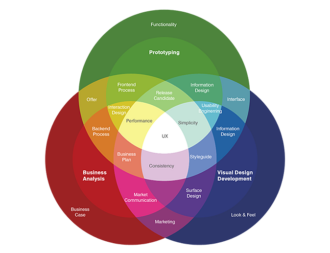One of the biggest challenges as a freelance designer isn’t the work itself. It’s finding clients.
Seasoned freelancers often have the luxury of client referrals from previous jobs to bring them new leads. But what if you’re just getting started as a freelance web designer? How do you find your first few clients?
The path to freelancing is different for everyone. You’re not showing up to a 9-to-5 office job where the expectations are laid out for you. You’re responsible for marketing your services and bringing clients in the door. There are no set rules, so you have the freedom to get creative.
With this in mind, here are six tips to help you effectively market yourself, connect with people who can refer you, and land new clients.
Ways to get web design clients
1. Pick a niche
Before you begin marketing your services, you should narrow down your niche. This will help you stand apart in a sea of competitors as well as define the types of clients that you’ll be going after.
If you’re a specialist in a certain industry, you’ll stand out to prospects as an authority in your field as opposed to being a generalist. You’ll even pick up on industry jargon that will improve your work and credibility.
The beauty of picking a niche as a freelancer is that it isn’t set in stone. Some freelancers hesitate to pick one because they’re worried about getting stuck with it.
Don’t let this slow you down. Pick a specialty and keep moving forward. If later on down the road you feel what you chose isn’t for you, there’s no rule against pivoting to something that’s a better fit.
There’s also no limit to what niche you can pick. But it helps to leverage any existing experience. For example, if you have five years’ experience working in the graphic design department for a construction company, you might consider specializing in designing websites for construction firms.
2. Narrow down your service offerings
Determining the services you offer is just as important as picking a specialty. As you already know, web design encompasses a range of services. You don’t have to be an expert in all of them or even offer all of them. Just as your chosen niche is flexible, so are your services. You can scale back or ramp up your offerings at any time.
A few examples of services you could offer your web design clients include
- Logo design
- Responsive websites
- Portfolio pages
- 3D animation
- WordPress installation
- Joomla customization
- Multimedia presentations
- Landing pages
- Sales/pitch decks
3. Invest in your own websites
It’s difficult to sell your services as a web designer if you don’t have a website yourself. If you’re in a time crunch, it’s acceptable to use a template or premade theme to get your website up and running as quickly as possible. As long as it looks professional, your potential clients won’t mind that it isn’t completely customized.
But no matter how simple or elaborate your website is, it needs to include some key components to help you get clients. For example, your contact information needs to be easy to find. You should include a portfolio of previous work, even if it’s something you created for the sole purpose of being an example.
Add information about your services and experience, if applicable. The icing on the cake — but not a requirement by any means — is a landing page for capturing leads.
4. Get active on social
As a freelancer, you don’t need a presence on every social platform. Simply pick one or two social platforms to get started.
It’s important to actively engage with your audience on your chosen platforms. Being on more than two in the beginning can get overwhelming, and you may not be able to handle being active on all of them. You can always expand your social media presence to additional platforms once you have a handle on the first ones.
It helps to include links to your website in your profile as well as a basic elevator pitch that describes who you help and the services you offer. You can create an individual profile or a business profile, whichever makes sense for your business structure.
For example, if you freelance as a sole proprietor using your name only, then it may make sense to have an individual account. If you freelance as an LLC or S corporation, it would be better to create a business profile. This is true even if you’re the only “employee.”
Whether you’re focusing on Facebook, LinkedIn, Instagram, or another platform, make sure to fill out as much information about your business as possible so potential clients can find you through search engines.
For instance, if you use LinkedIn, don’t just list “Web Designer” as your job title. Include more relevant details to help potential clients find you in the search results, such as “Freelance WordPress Developer for SaaS Companies.” It pays to be specific.
5. Create a free offer
Giving people free advice, content, or a sample of your services at no cost is often helpful for generating leads. In exchange for the freebie, you get the person’s email address, and you can gain other insights into their business. Plus, it’s an excellent way to provide value to potential clients, earn their trust, boost your credibility, and prequalify your leads all at once.
For example, let’s say you design websites for attorneys. You could offer a free e-book that discusses current design trends for law firm websites. Anyone interested would need to enter their email address and sign up for your newsletter.
The e-book would demonstrate your expertise, and you could continue sending valuable insights and updates to leads via your newsletter. When a potential client decides to move forward with a new design for their website, you’ll likely be top of mind and already established as a trusted expert.
6. Connect with fellow freelancers
Many new freelancers mistakenly think they have to work in a vacuum — that it’s them against every other freelancer or agency out there. This kind of thinking can actually cost you business. Just as you specialize or excel in certain niches, others do the same. Instead, use social networks to connect with other freelancers offering services that could complement your own.
For example, a web designer could pair with a copywriter. The client, as well as the other freelancer, would benefit from the bundled service or the referral. When the copywriter needed a designer for one of their clients, you would get their referral.
Not only would you benefit from the additional leads, but you could also pick up tips and tricks from collaborating with other freelancers. Freelancers who have been in business longer than you often have advice and stories to share. Tap into their knowledge and be willing to share your expertise as well.
The key to getting clients as a freelancer is to keep testing. So if you aren’t getting leads through Facebook, try LinkedIn or Instagram. If you aren’t getting any bites for your lead-generation e-book, then try offering a free website analysis instead.
As a freelancer, you work for yourself. When you find a lead-generation method that works for you, run with it.
















































































Send Comment: